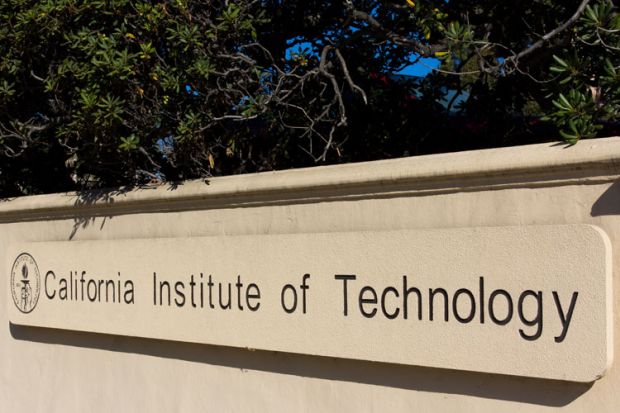Caltech Astronomers Spot Extremely Warped Supernova
Astronomers have captured a bizarre image of a supernova, the powerful explosion of a star, whose light was so warped by the gravity of another galaxy that it appears as multiple images in the sky. This effect, known as gravitational lensing, occurs when the gravity of a dense object distorts and brightens the light of an object behind it.
Dubbed “SN Zwicky,” the supernova was first spotted by the Caltech-led Zwicky Transient Facility, or ZTF, as part of what is currently the largest supernova survey to date. ZTF is based at the Palomar Observatory near San Diego.
“With ZTF, we have the unique ability to catch and classify supernovae in near real time. We noticed that SN Zwicky was brighter than it should have been given its distance to us and quickly realized that we were seeing a very rare phenomenon called strong gravitational lensing,” says Ariel Goobar, lead author of the study published today in Nature Astronomy and the director of the Oskar Klein Center at the University of Stockholm in Sweden. “Such lensed objects can help us to uniquely probe the amount and distribution of matter at the inner core of galaxies.”
As predicted by Albert Einstein more than a century ago, light from one cosmic object that encounters a dense object on its way to us can undergo gravitational lensing. The dense object acts like a lens that can bend and focus the light. Depending on how dense the lens is and the distance between the lens and us, this warping effect can vary in strength. With strong lensing, the light from the cosmic object is so distorted that it is magnified and split into several copies of the same image.
Astronomers have been observing the gravitational bending of light since 1919, just a few years after Einstein developed the theory, but the transient nature of supernovae makes events such as SN Zwicky, also known as SN 2022qmx, very hard to spot. In fact, while scientists have spotted lensed duplicated images of distant objects called quasars many times before, only a handful of supernovae lensed into duplicated images have been found. Two of these cases were found at Palomar: SN Zwicky, and ciPTF16geu, discovered by the intermediate Palomar Transient Factory (iPTF), a predecessor to ZTF.
“SN Zwicky is the smallest resolved gravitational lens system found with optical telescopes. iPTF16geu was a wider system but had larger magnification,” says Goobar.
Goobar and his international team employed a suite of astronomical facilities to follow up and study SN Zwicky after it was discovered by ZTF. The Near-IR Camera 2 (NIRC2) at the W. M. Keck Observatory on Maunakea in Hawai‘i resolved SN Zwicky, revealing that the lensing of the supernova was strong enough to have created multiple images of the same object.
“I was observing that night and was absolutely stunned when I saw the lensed image of SN Zwicky,” says Christoffer Fremling, a staff astronomer at the Caltech Optical Observatory who leads the ZTF supernova survey, called the Bright Transient Survey. “We catch and classify thousands of transients with the Bright Transient Survey, and that gives us a unique ability to find very rare phenomena such as SN Zwicky.”
SN Zwicky is what is known as a Type Ia supernova. These are dying stars that end their lives with a light show that is always the same in brightness from event to event. This unique property was used to reveal the accelerated expansion of our universe back in 1998 due to a yet unknown phenomenon called dark energy.
“Strongly lensed Type Ia supernovae allow us to see further back in time because they are magnified. Observing more of them will give us an unprecedented chance to explore the nature of dark energy,” says Joel Johansson, a postdoctoral fellow at Stockholm University and a co-author on the study.
“What are missing components needed to model the expansion history of the universe? What is the dark matter that makes up the vast majority of the mass in galaxies? As we discover more ‘SN Zwickys’ with ZTF and the upcoming Vera Rubin Observatory, we will have another tool to chip away at the mysteries of the universe and find answers,” says Goobar.
To date, the ZTF Bright Transient Survey has discovered 7,811 confirmed supernovae. The main goal of the survey is to catalog and classify all extragalactic explosions that the instrument can reliably detect. Because ZTF rapidly scans wide swaths of the sky, it is currently the largest and most complete survey of its kind. Astronomers around the world use the Bright Transient Survey to find out what kinds of cosmic explosions exist, how common they are, and how bright they can get.
The study titled “Uncovering a population of gravitational lens galaxies with magnified standard candle SN Zwicky,” was funded by Knut and Alice Wallenberg Foundation, the Swedish National Science Foundation Vetenskapsrådet, the Swedish Research Council, and the European Research Council. Facilities used for this study include ZTF on the Samuel Oschin Telescope at the Palomar Observatory, the Liverpool Telescope, the Nordic Optical Telescope, the Keck Observatory, the Very Large Telescope in Chile, and the Hubble Space Telescope.
Caltech’s ZTF is funded by the National Science Foundation and an international collaboration of partners. Additional support comes from the Heising–Simons Foundation and from Caltech. ZTF data are processed and archived by IPAC, an astronomy center based at Caltech. NASA supports ZTF’s search for near-Earth objects through the Near-Earth Object Observations Program.

